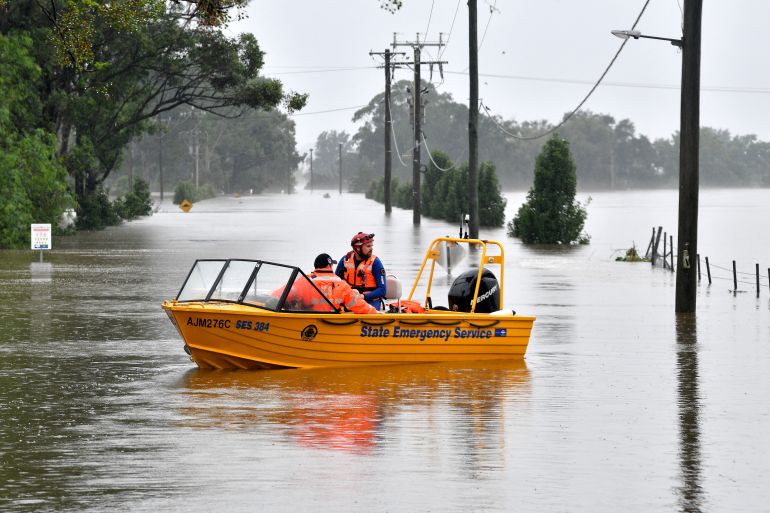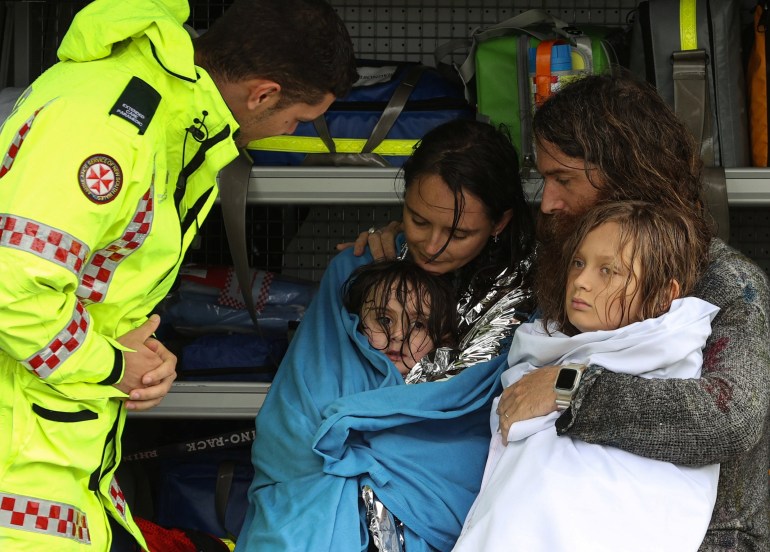More evacuations amid ‘catastrophic’ floods in eastern Australia
Authorities extend flood and severe weather warnings to more areas, send helicopters to rescue stranded people.

Authorities in eastern Australia have issued fresh flood warnings and evacuation orders amid a relentless week-long downpour, as emergency services deployed helicopters and boats to rescue residents stranded by “catastrophic” floodwaters.
In New South Wales (NSW), the worst-affected state, a fourth-consecutive day of heavy rain on Tuesday was expected to combine with a coastal trough over the coming 24 hours to increase the deluge.
Keep reading
list of 4 itemsEvacuations ordered in Sydney amid ‘one-in-100-year floods’
Sydney suburbs in lockdown, new border curbs after COVID outbreak
Australia parliament debates motion on Uighur abuses in Xinjiang
Flood and severe weather warnings were extended to areas not previously affected, including the south coast of Sydney, Australia’s largest city, and outback areas to the northwest, which were recently crippled by a prolonged drought.
So far, no fatalities or serious injuries have been reported, but thousands of homes and businesses are believed to have been damaged.
About 18,000 people have been evacuated.
Severe Weather Update: #flooding for #Sydney and Eastern #NSW and heavy #rainfall for eastern #Vic and #Tas. Video current at 2.00pm AEDT 23 March, 2021.
Latest forecasts: https://t.co/ffE8FUllCs or the #BOMWeather app and please follow the advice of emergency services. pic.twitter.com/2Zhy9j5AXG
— Bureau of Meteorology, Australia (@BOM_au) March 23, 2021
Strained emergency services, which just over a year ago were battling unprecedented bushfires, used military aircraft and watersports equipment, including jet skis, to access cut-off communities. They said they have responded to more than 10,000 calls for help.
In Pitt Town, on the northwestern outskirts of Sydney, resident Paul Zimmat said several people were stranded in the area due to floodwaters.
“The township is blocked off,” he told Al Jazeera. “A few of my friends are stuck there. I spoke to them this morning, and they say they hope to come out in the next day or two.”
Al Jazeera’s Nicola Gage, reporting from Pitt Town, said “it’s still a dangerous situation for most people”.
“Thousands more people are on standby, waiting to evacuate. But there is some relief,” she added. “On Tuesday night and Wednesday, the rains are expected to ease. But the government says that does not mean the danger will go away, as rivers are still expected to rise.”
‘Not out of the woods’
Pictures and videos on social media sites showed entire bridges washed away, stranded animals and submerged homes. One video showed a container truck ramming into a bridge in NSW, causing considerable structural damage, while another showed a car being swept off a road by raging floodwaters in Queensland.
Organic farmer Rod Bailey said his property near Port Macquarie in NSW had suffered “complete devastation” with at least 95 percent of his crops destroyed by heavy rains.
“We won’t see any income short of three months,” he told AFP news agency. “It’s a difficult situation we’re in but many of our neighbours have had it far worse.”
Australia’s Bureau of Meteorology has now posted severe weather warnings in every mainland state or territory but one, affecting 10 million people in the country of 25 million. It warned on Tuesday that “we are not out of the woods yet”, with half of NSW still under emergency weather warnings.


Gladys Berejiklian, the premier of NSW, said the wild weather was now “impacting a huge area of the state”.
“It is catastrophic in its dimensions and the impact will be severe, and the fact that 15,000 people may need to be evacuated within the next 24 to 48 hours is a huge concern,” she said.
State Emergency Service Assistant Commissioner Nicole Hogan told public broadcaster ABC a further 1,750 volunteers had arrived from interstate to support the efforts in what would be a “critical 24 hours”.
Prime Minister Scott Morrison said the Warragamba Dam, Sydney’s main drinking water source, was expected to continue spilling over into already swollen rivers for another week.
“This is a complex weather event and becoming more complex,” he told reporters in Canberra.
Morrison urged people to follow the advice of authorities.
“No lives to this point have been lost thankfully, we pray that will continue to be the situation,” he said.